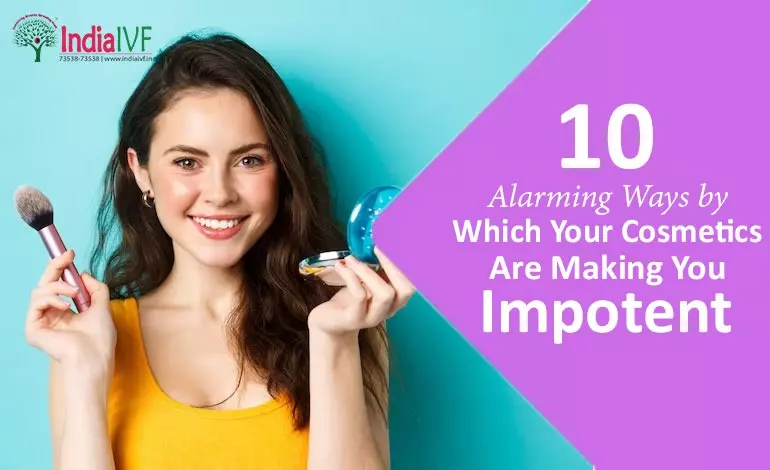Your cart is currently empty!



Life is a wonderful dance of sequences and patterns, from the seasonal bloom of flowers to the complexity of human conception. But what happens when unexpected factors disrupt these natural rhythms? For instance, could the cosmetics we use be silently contributing to infertility issues? This article, presented by India IVF Fertility – a top-tier fertility clinic with a reputation for excellence in Delhi, Noida, Gurgaon and Gwalior – aims to answer these questions and shed light on this rarely discussed topic.
While the idea may seem far-fetched, scientific research supports the potential link between certain chemicals in our cosmetics and fertility complications. That’s why we’re outlining ten ways in which your cosmetics might be contributing to impotence, emphasizing the importance of conscious consumption and lifestyle adjustments.
Parabens are a common preservative in cosmetics. They keep your products fresh but can mimic estrogen, leading to hormonal imbalances and potential fertility issues.
Phthalates are used in everything from nail polish to hairspray to enhance flexibility and durability. Studies have suggested a link between these chemicals and reduced sperm motility.
While banned in many countries, some cosmetics still contain traces of lead. Even in small quantities, lead exposure has been linked to decreased sperm count and quality.
Used to prevent bacterial contamination, triclosan is a common ingredient in soaps, deodorants, and toothpaste. Yet, research suggests that triclosan can disrupt the thyroid hormone, critical for normal growth and development, potentially causing fertility problems.
These chemicals absorb UV light and are present in many sunscreens and lip balms. Disturbingly, they can interfere with the endocrine system, disrupting hormonal balance and potentially impacting fertility.
A known carcinogen, formaldehyde can be found in nail polishes and hair smoothing products. While research is ongoing, formaldehyde exposure has been implicated in fertility issues, including lower sperm count.
Often found in nail polish and hair dye, toluene can affect the central nervous system and lead to reproductive harm. Studies show that high exposure levels can cause testicular damage and impotence.
The term ‘fragrance’ can refer to hundreds of different chemicals, some of which may disrupt hormones and impair fertility. It’s advisable to choose fragrance-free products or those scented with natural oils.
Although it’s banned in most countries, mercury can still be found in some skin lightening creams and soaps. Mercury exposure is toxic and can lead to fertility problems by causing chromosomal abnormalities in sperm.
PFAS are used to make products more resistant to stains, grease, and water, including water-resistant cosmetics. They can interfere with hormones, and research has linked them to decreased semen quality.
Navigating the world of cosmetics can feel like walking through a minefield, especially when considering potential fertility issues. However, by arming ourselves with knowledge and making conscious choices, we can mitigate these risks. The key lies in understanding the possible impacts of the products we use daily and taking proactive measures to safeguard our reproductive health.
Remember, it’s not about completely shunning cosmetics but rather about informed decision-making. With this guide from India IVF Fertility, we hope to have given you a head-start on this journey.
Not all cosmetics are harmful to fertility. However, many contain chemicals that could potentially affect reproductive health. Opt for products labelled as "paraben-free" or "phthalate-free".
Limit your use of cosmetics, particularly those that list harmful chemicals in their ingredients. Opt for natural, organic products when possible.
Some effects may be reversible by eliminating exposure to these chemicals, but each case is unique. Consult a fertility expert for personalized advice.
Not necessarily. They can be found in both high-end and budget products. Always check the ingredients list.
No, women can also experience fertility issues due to exposure to these chemicals. It can disrupt hormonal balance, leading to menstrual irregularities and even early menopause.
Regulatory bodies can enforce stricter rules on cosmetic manufacturers, such as banning certain chemicals and requiring more transparent labelling.
While organic products generally contain fewer harmful chemicals, they may still contain some of these substances. Always read the label carefully.
While we can't endorse specific brands, look for those that prioritize natural ingredients and avoid the chemicals listed above.
Yes, certain tests can measure levels of these chemicals in the body. If you're concerned about your exposure, talk to your healthcare provider.
Regular exercise, a balanced diet, adequate sleep, and stress management can all contribute to better reproductive health.
At India IVF Clinics we provide the most comprehensive range of services to cover all the requirements at a Fertility clinic including in-house lab, consultations & treatments.